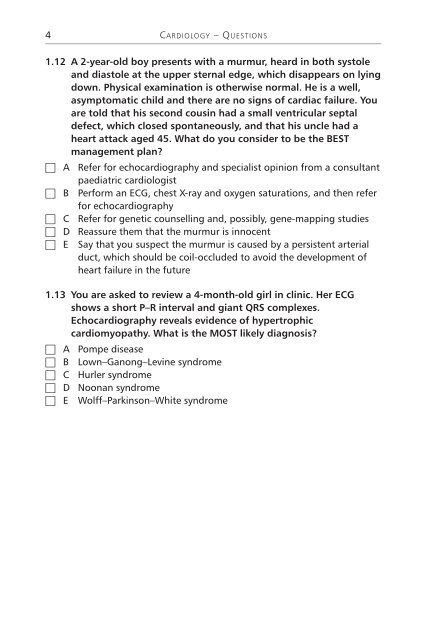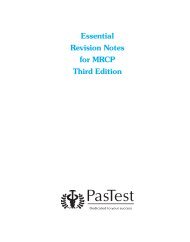MRCPCH 1: Essential Questions in Paediatrics - PasTest
MRCPCH 1: Essential Questions in Paediatrics - PasTest
MRCPCH 1: Essential Questions in Paediatrics - PasTest
- No tags were found...
Create successful ePaper yourself
Turn your PDF publications into a flip-book with our unique Google optimized e-Paper software.
4CARDIOLOGY – QUESTIONS1.12 A 2-year-old boy presents with a murmur, heard <strong>in</strong> both systoleand diastole at the upper sternal edge, which disappears on ly<strong>in</strong>gdown. Physical exam<strong>in</strong>ation is otherwise normal. He is a well,asymptomatic child and there are no signs of cardiac failure. Youare told that his second cous<strong>in</strong> had a small ventricular septaldefect, which closed spontaneously, and that his uncle had aheart attack aged 45. What do you consider to be the BESTmanagement plan? A Refer for echocardiography and specialist op<strong>in</strong>ion from a consultantpaediatric cardiologist B Perform an ECG, chest X-ray and oxygen saturations, and then referfor echocardiography C Refer for genetic counsell<strong>in</strong>g and, possibly, gene-mapp<strong>in</strong>g studies D Reassure them that the murmur is <strong>in</strong>nocent E Say that you suspect the murmur is caused by a persistent arterialduct, which should be coil-occluded to avoid the development ofheart failure <strong>in</strong> the future1.13 You are asked to review a 4-month-old girl <strong>in</strong> cl<strong>in</strong>ic. Her ECGshows a short P–R <strong>in</strong>terval and giant QRS complexes.Echocardiography reveals evidence of hypertrophiccardiomyopathy. What is the MOST likely diagnosis? A Pompe disease B Lown–Ganong–Lev<strong>in</strong>e syndrome C Hurler syndrome D Noonan syndrome E Wolff–Park<strong>in</strong>son–White syndrome
















